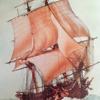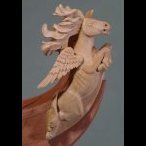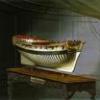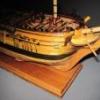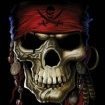-
Posts
1,267 -
Joined
-
Last visited
Reputation Activity
-
 AnobiumPunctatum reacted to dvm27 in HM Sloop Fly by AnobiumPunctatum - 1:32 - POF
AnobiumPunctatum reacted to dvm27 in HM Sloop Fly by AnobiumPunctatum - 1:32 - POF
Your approach to the rising wood will help you immeasurably when it comes to raising the frames, Christian. Well done!
-
 AnobiumPunctatum reacted to albert in HM Sloop Fly by AnobiumPunctatum - 1:32 - POF
AnobiumPunctatum reacted to albert in HM Sloop Fly by AnobiumPunctatum - 1:32 - POF
Very very nice work Christian.
-
 AnobiumPunctatum got a reaction from Eddie in HM Sloop Fly by AnobiumPunctatum - 1:32 - POF
AnobiumPunctatum got a reaction from Eddie in HM Sloop Fly by AnobiumPunctatum - 1:32 - POF
After a Long time I can Show new Progress of the build of my Sloop. After the stem I started building the lower and upper apron. Especially the lower apron, was really difficult. I need three trys until I get an result which I decided to use for my build. I think that I wouldn't get it better. I accent all glueing joints with brown color. After finishing the stem looks as in the following picture: David Shows in his book a simplified method for Building the rising woodI decided to follow the more detailed way, because I have a very precise Position of every second Frame. I think that this will help me in the future. I used this simple dummy frame during the build for checking the wide of the notches
Next step will be the after deadwood.
-
 AnobiumPunctatum got a reaction from davec in HM Sloop Fly by AnobiumPunctatum - 1:32 - POF
AnobiumPunctatum got a reaction from davec in HM Sloop Fly by AnobiumPunctatum - 1:32 - POF
After a Long time I can Show new Progress of the build of my Sloop. After the stem I started building the lower and upper apron. Especially the lower apron, was really difficult. I need three trys until I get an result which I decided to use for my build. I think that I wouldn't get it better. I accent all glueing joints with brown color. After finishing the stem looks as in the following picture: David Shows in his book a simplified method for Building the rising woodI decided to follow the more detailed way, because I have a very precise Position of every second Frame. I think that this will help me in the future. I used this simple dummy frame during the build for checking the wide of the notches
Next step will be the after deadwood.
-
 AnobiumPunctatum got a reaction from mmdd in Young America 1853 by EdT - FINISHED - extreme clipper
AnobiumPunctatum got a reaction from mmdd in Young America 1853 by EdT - FINISHED - extreme clipper
Really wonderful, Ed. I love your precision. It looks so absolut easy but is so very difficult to reach.
-
 AnobiumPunctatum reacted to tadheus in La Salamandre by tadheus - 1:24
AnobiumPunctatum reacted to tadheus in La Salamandre by tadheus - 1:24
Continuation.
The beginning of the relation is available at this address:
http://5500.forumact...ndre-1-24#66516
Regards, Pawel
-
 AnobiumPunctatum reacted to tadheus in La Salamandre by tadheus - 1:24
AnobiumPunctatum reacted to tadheus in La Salamandre by tadheus - 1:24
Continuation.
The beginning of the relation is available at this address:
http://5500.forumact...ndre-1-24#66516
Regards, Pawel
-
 AnobiumPunctatum got a reaction from zoly99sask in HM Sloop Fly by AnobiumPunctatum - 1:32 - POF
AnobiumPunctatum got a reaction from zoly99sask in HM Sloop Fly by AnobiumPunctatum - 1:32 - POF
After a Long time I can Show new Progress of the build of my Sloop. After the stem I started building the lower and upper apron. Especially the lower apron, was really difficult. I need three trys until I get an result which I decided to use for my build. I think that I wouldn't get it better. I accent all glueing joints with brown color. After finishing the stem looks as in the following picture: David Shows in his book a simplified method for Building the rising woodI decided to follow the more detailed way, because I have a very precise Position of every second Frame. I think that this will help me in the future. I used this simple dummy frame during the build for checking the wide of the notches
Next step will be the after deadwood.
-
 AnobiumPunctatum got a reaction from EdT in HM Sloop Fly by AnobiumPunctatum - 1:32 - POF
AnobiumPunctatum got a reaction from EdT in HM Sloop Fly by AnobiumPunctatum - 1:32 - POF
After a Long time I can Show new Progress of the build of my Sloop. After the stem I started building the lower and upper apron. Especially the lower apron, was really difficult. I need three trys until I get an result which I decided to use for my build. I think that I wouldn't get it better. I accent all glueing joints with brown color. After finishing the stem looks as in the following picture: David Shows in his book a simplified method for Building the rising woodI decided to follow the more detailed way, because I have a very precise Position of every second Frame. I think that this will help me in the future. I used this simple dummy frame during the build for checking the wide of the notches
Next step will be the after deadwood.
-
 AnobiumPunctatum got a reaction from dgbot in Young America 1853 by EdT - FINISHED - extreme clipper
AnobiumPunctatum got a reaction from dgbot in Young America 1853 by EdT - FINISHED - extreme clipper
Really wonderful, Ed. I love your precision. It looks so absolut easy but is so very difficult to reach.
-
 AnobiumPunctatum got a reaction from Archi in HM Sloop Fly by AnobiumPunctatum - 1:32 - POF
AnobiumPunctatum got a reaction from Archi in HM Sloop Fly by AnobiumPunctatum - 1:32 - POF
After a Long time I can Show new Progress of the build of my Sloop. After the stem I started building the lower and upper apron. Especially the lower apron, was really difficult. I need three trys until I get an result which I decided to use for my build. I think that I wouldn't get it better. I accent all glueing joints with brown color. After finishing the stem looks as in the following picture: David Shows in his book a simplified method for Building the rising woodI decided to follow the more detailed way, because I have a very precise Position of every second Frame. I think that this will help me in the future. I used this simple dummy frame during the build for checking the wide of the notches
Next step will be the after deadwood.
-
 AnobiumPunctatum got a reaction from albert in HM Sloop Fly by AnobiumPunctatum - 1:32 - POF
AnobiumPunctatum got a reaction from albert in HM Sloop Fly by AnobiumPunctatum - 1:32 - POF
After a Long time I can Show new Progress of the build of my Sloop. After the stem I started building the lower and upper apron. Especially the lower apron, was really difficult. I need three trys until I get an result which I decided to use for my build. I think that I wouldn't get it better. I accent all glueing joints with brown color. After finishing the stem looks as in the following picture: David Shows in his book a simplified method for Building the rising woodI decided to follow the more detailed way, because I have a very precise Position of every second Frame. I think that this will help me in the future. I used this simple dummy frame during the build for checking the wide of the notches
Next step will be the after deadwood.
-
 AnobiumPunctatum got a reaction from Trussben in HM Sloop Fly by AnobiumPunctatum - 1:32 - POF
AnobiumPunctatum got a reaction from Trussben in HM Sloop Fly by AnobiumPunctatum - 1:32 - POF
After a Long time I can Show new Progress of the build of my Sloop. After the stem I started building the lower and upper apron. Especially the lower apron, was really difficult. I need three trys until I get an result which I decided to use for my build. I think that I wouldn't get it better. I accent all glueing joints with brown color. After finishing the stem looks as in the following picture: David Shows in his book a simplified method for Building the rising woodI decided to follow the more detailed way, because I have a very precise Position of every second Frame. I think that this will help me in the future. I used this simple dummy frame during the build for checking the wide of the notches
Next step will be the after deadwood.
-
 AnobiumPunctatum got a reaction from oneslim in Young America 1853 by EdT - FINISHED - extreme clipper
AnobiumPunctatum got a reaction from oneslim in Young America 1853 by EdT - FINISHED - extreme clipper
Really wonderful, Ed. I love your precision. It looks so absolut easy but is so very difficult to reach.
-
 AnobiumPunctatum reacted to Chuck in HM Sloop Fly by AnobiumPunctatum - 1:32 - POF
AnobiumPunctatum reacted to Chuck in HM Sloop Fly by AnobiumPunctatum - 1:32 - POF
Beautiful work. It is so nice to see you back working on the model.
Well Done!!!
-
 AnobiumPunctatum got a reaction from CaptainSteve in Young America 1853 by EdT - FINISHED - extreme clipper
AnobiumPunctatum got a reaction from CaptainSteve in Young America 1853 by EdT - FINISHED - extreme clipper
Really wonderful, Ed. I love your precision. It looks so absolut easy but is so very difficult to reach.
-
 AnobiumPunctatum got a reaction from Mike 41 in HM Sloop Fly by AnobiumPunctatum - 1:32 - POF
AnobiumPunctatum got a reaction from Mike 41 in HM Sloop Fly by AnobiumPunctatum - 1:32 - POF
After a Long time I can Show new Progress of the build of my Sloop. After the stem I started building the lower and upper apron. Especially the lower apron, was really difficult. I need three trys until I get an result which I decided to use for my build. I think that I wouldn't get it better. I accent all glueing joints with brown color. After finishing the stem looks as in the following picture: David Shows in his book a simplified method for Building the rising woodI decided to follow the more detailed way, because I have a very precise Position of every second Frame. I think that this will help me in the future. I used this simple dummy frame during the build for checking the wide of the notches
Next step will be the after deadwood.
-
 AnobiumPunctatum got a reaction from Captain Poison in HM Sloop Fly by AnobiumPunctatum - 1:32 - POF
AnobiumPunctatum got a reaction from Captain Poison in HM Sloop Fly by AnobiumPunctatum - 1:32 - POF
After a Long time I can Show new Progress of the build of my Sloop. After the stem I started building the lower and upper apron. Especially the lower apron, was really difficult. I need three trys until I get an result which I decided to use for my build. I think that I wouldn't get it better. I accent all glueing joints with brown color. After finishing the stem looks as in the following picture: David Shows in his book a simplified method for Building the rising woodI decided to follow the more detailed way, because I have a very precise Position of every second Frame. I think that this will help me in the future. I used this simple dummy frame during the build for checking the wide of the notches
Next step will be the after deadwood.
-
 AnobiumPunctatum got a reaction from garyri in Young America 1853 by EdT - FINISHED - extreme clipper
AnobiumPunctatum got a reaction from garyri in Young America 1853 by EdT - FINISHED - extreme clipper
Really wonderful, Ed. I love your precision. It looks so absolut easy but is so very difficult to reach.
-
 AnobiumPunctatum got a reaction from hexnut in HM Sloop Fly by AnobiumPunctatum - 1:32 - POF
AnobiumPunctatum got a reaction from hexnut in HM Sloop Fly by AnobiumPunctatum - 1:32 - POF
After a Long time I can Show new Progress of the build of my Sloop. After the stem I started building the lower and upper apron. Especially the lower apron, was really difficult. I need three trys until I get an result which I decided to use for my build. I think that I wouldn't get it better. I accent all glueing joints with brown color. After finishing the stem looks as in the following picture: David Shows in his book a simplified method for Building the rising woodI decided to follow the more detailed way, because I have a very precise Position of every second Frame. I think that this will help me in the future. I used this simple dummy frame during the build for checking the wide of the notches
Next step will be the after deadwood.
-
 AnobiumPunctatum got a reaction from tlevine in HM Sloop Fly by AnobiumPunctatum - 1:32 - POF
AnobiumPunctatum got a reaction from tlevine in HM Sloop Fly by AnobiumPunctatum - 1:32 - POF
After a Long time I can Show new Progress of the build of my Sloop. After the stem I started building the lower and upper apron. Especially the lower apron, was really difficult. I need three trys until I get an result which I decided to use for my build. I think that I wouldn't get it better. I accent all glueing joints with brown color. After finishing the stem looks as in the following picture: David Shows in his book a simplified method for Building the rising woodI decided to follow the more detailed way, because I have a very precise Position of every second Frame. I think that this will help me in the future. I used this simple dummy frame during the build for checking the wide of the notches
Next step will be the after deadwood.
-
 AnobiumPunctatum got a reaction from mtaylor in Young America 1853 by EdT - FINISHED - extreme clipper
AnobiumPunctatum got a reaction from mtaylor in Young America 1853 by EdT - FINISHED - extreme clipper
Really wonderful, Ed. I love your precision. It looks so absolut easy but is so very difficult to reach.
-
 AnobiumPunctatum got a reaction from druxey in HM Sloop Fly by AnobiumPunctatum - 1:32 - POF
AnobiumPunctatum got a reaction from druxey in HM Sloop Fly by AnobiumPunctatum - 1:32 - POF
After a Long time I can Show new Progress of the build of my Sloop. After the stem I started building the lower and upper apron. Especially the lower apron, was really difficult. I need three trys until I get an result which I decided to use for my build. I think that I wouldn't get it better. I accent all glueing joints with brown color. After finishing the stem looks as in the following picture: David Shows in his book a simplified method for Building the rising woodI decided to follow the more detailed way, because I have a very precise Position of every second Frame. I think that this will help me in the future. I used this simple dummy frame during the build for checking the wide of the notches
Next step will be the after deadwood.
-
 AnobiumPunctatum reacted to EdT in Young America 1853 by EdT - FINISHED - extreme clipper
AnobiumPunctatum reacted to EdT in Young America 1853 by EdT - FINISHED - extreme clipper
Young America - extreme clipper 1853
Part 182 – Made Masts
At 36" in diameter, there is little doubt that Young America's fore and main lower masts were built up of multiple pieces – so called "made masts". Beyond that, the details of their construction is speculative. Masts were made in a variety of ways – probably dependent on the mast maker's methods and certainly on the available timber. Most made mast construction featured a central core, a "spindle" that may have been of one or multiple pieces. Attached to the sides of this were "side trees" over the lower to upper mid-length with additional side "cheeks" up to the "stop" at the top of the square "hounds" that supported the top. These might be integral with the cheeks or separate pieces. Timber pieces that filled out the fore and aft faces, "fish" completed the typical body of the mast. Often, each of these pieces consisted of multiple members. All these pieces were fitted together with a variety of hidden mortises and the pieces were often made as long scarphs. I had no intention of trying to duplicate these complex assemblies, especially without knowledge of the actual original masts. I chose a simpler design for the model fore and main masts that consists of a single spindle squared over the full length of the mast to the dimension of the doubling – the square section above the stop. Two side cheeks and two fish over the full rounded length were used to fill out the size of the squared mast that was then shaped as described in the last part.
The first picture shows the five parts of the lower foremast.
The next picture shows the first two sides glued to the spindle.
Dark glue was used to yield a subtle joint line. These first pieces were cut just larger than the spindle so they could be scraped flush to provide a flat surface for the remaining parts. The scraper blade in the upper corner of the picture was used for this step. In the next picture the assembled stick has been marked at the quarters and on the centerline. The dividers are being used to mark the breadths at each point.
In the next picture two sides are being sanded to the line – the so-called second trim.
After marking these sanded sides, shaping them as above in the third trim, and then marking the apices of the octagon, the corners were removed. The first step, planing, is shown below.
After forming the regular octagon, the mast was rounded using the tools shown in the next picture – a rasp, a medium flat file, and a medium-fine barrette..
The lower end of the mast is shown in this picture. It will be cut off and the step tenon formed by filing down the square spindle to the size of the step mortise.
The three bare lower masts are shown positioned on the steps in the last picture.
The next step on all these spars, bowsprit and masts, is the iron banding. These round hoops must be fitted over the masts before the installation of the hounds.
Ed
-
 AnobiumPunctatum got a reaction from NJQUACK in HM Sloop Fly by AnobiumPunctatum - 1:32 - POF
AnobiumPunctatum got a reaction from NJQUACK in HM Sloop Fly by AnobiumPunctatum - 1:32 - POF
After a Long time I can Show new Progress of the build of my Sloop. After the stem I started building the lower and upper apron. Especially the lower apron, was really difficult. I need three trys until I get an result which I decided to use for my build. I think that I wouldn't get it better. I accent all glueing joints with brown color. After finishing the stem looks as in the following picture: David Shows in his book a simplified method for Building the rising woodI decided to follow the more detailed way, because I have a very precise Position of every second Frame. I think that this will help me in the future. I used this simple dummy frame during the build for checking the wide of the notches
Next step will be the after deadwood.







